Chicken and Andouille Gumbo, sometimes called Gumbo Ya-Ya, starts with a dark roux and builds its foundation with the Trinity and traditional Cajun seasonings before simmering with chicken and andouille sausage in a rich chicken stock. Like most gumbos, preparation takes a little time, but with good ingredients and the proper process, you’ll find this flavor-pack gumbo is quite easy to make and completely no-angst!

This post is not sponsored, but you will find affiliate links on this page. As an Amazon Associate, I earn from qualifying purchases. The price you pay as a consumer does not change, but I may make a small commission based on your purchase.
Jump to:
What is Gumbo?
"Gumbo" is a small word that packs a lot of punch. Recognized as the Official State Dish of Louisiana, gumbo epitomizes the melding of the various cultural influences in South Louisiana. I’ve seen gumbo defined as “a soup-like dish featuring two or more meats or seafood and served with rice”. That simple, textbook definition doesn't even come close to defining this heavily seasoned dish with a lot of nuances.
Ask any Cajun or Creole cook what gumbo is and you will get very definitive but different answers and little consensus as to what exactly must go into gumbo. There are three basic types, poultry gumbo, seafood gumbo, and green or herb gumbo, but many varieties of each. Should there be a roux, do you need okra, and what about file’? Do tomatoes go in gumbo? Regional and family traditions result in the many variations of gumbo.
What is Gumbo Ya-Ya?
Typical of Cajun recipes, Chicken and Sausage Gumbo (poultry gumbo) is made with simple techniques and simple ingredients that were readily available in the early settlement days of Acadiana. Chef Paul Prudhomme labeled Chicken and Andouille Sausage gumbo “Gumbo Ya-Ya”, a term meaning “everyone talking at once”, referring to continuous chatter at the dinner table. Chef Paul drew on his Cajun roots to popularize this classic Gumbo, which has been broadly adopted and adapted in large and small regional restaurants and home kitchens throughout South Louisiana.
All I know is that I’ve never had a gumbo I didn’t love and this Gumbo Ya-Ya is my favorite. I’m glad to share my no-angst recipe and methods with you.
Here’s What You Need
Here are some of the key ingredients for this recipe:

Note on the Chicken: You can use boneless/skinless breasts and thighs, cut up a whole chicken, or a store-roasted chicken. If you use a whole chicken, it's easy to make homemade chicken stock with it.
Note on the Andouille Sausage: Andouille is a highly seasoned smoked pork sausage found in many Cajun recipes. If you can't find Andouille in your grocery store, check out this andouille from The Best Stop in Scott, Louisiana. Substitutes are discussed in the Hints and Tips (FAQ) Section below.

Note on the Chicken Stock: Commercial chicken stock is perfect for this recipe. Check out my recipe for Homemade Chicken Stock; you can use the chicken meat for this gumbo after you make the stock. If neither of those work for you, substitue Better Than Bouillon.

Note on the Creole seasoning: This recipe was developed using Le Bon Papa Creole Seasoning, which is a No-Salt all-purpose Creole or Cajun seasoning. If you use another brand, make sure you check the salt content before adding any salt to this recipe.

Equipment
Here is some of the equipment I used in making this recipe:
This post is not sponsored, but you will find affiliate links on this page. As an Amazon Associate, I earn from qualifying purchases. The price you pay as a consumer does not change, but I may make a small commission based on your purchase.
This is a two-pot dish which means the recipe will be started in a Dutch oven and finished in a stockpot.
Here’s What You Do
First...you have a beer. With the delicious and rich way this recipe turns out you may think it's complicated. We’re going to make it no-angst by being prepared, practicing some mise en place and that starts with the chef. Pop the top of a beer and sit down and read the recipe all the way through. It's a really simple technique...build the foundation starting with the roux in one pan, then blend it all into a boiling stock in another pan. Read it all, then make sure you have what you need and you know what you will do with each ingredient.
Mise en place
Start with the stock:
Measure the stock right into a large stock pot. Set the stock pot aside and we will begin to warm it when we start preparing the roux.
Prepare the remaining ingredients:
- Chop the Trinity (yellow onions, celery, and bell peppers) and place all that into the same prep bowl.
- Chop the green onions and garlic and place them in separate prep bowls.
- Slice the sausage into medallions about ¼ inch thick, and set aside.
- Measure the oil and flour.
- Mix the Herb and Spice Blend (except the salt) in a small prep bowl.
Lagniappe Tip: Place the salt in a different prep bowl and leave it out until you taste the gumbo late in the process. The stock and the Creole seasoning you use may contain salt so you don't want to overdo it.

Brown the Sausage and Make a Dark Roux
What happens in this step: Sausage renderings mixed into a dark roux is the first important layer of flavor and color that will start to define this dish.

1) Place a cast iron Dutch oven over medium-high heat. When it's hot, fry the sausage until it starts to brown and render some of its fat, about 5 minutes. Remove the browned sausage from the Dutch oven and set aside leaving as much fat as possible in the pan.
Lagniappe Tip: Traditional andouille should have high-fat content, but the particular brand you use may not. Browning the sausage in the Dutch oven, regardless of how much fat is rendered will still produce lots of great flavor.
2) Add the vegetable oil to the Dutch oven. When the oil is very hot, sprinkle in the flour and stir or whisk constantly, blending all the oil and sausage fat with the flour to make a nice dark brown roux.
3) Pay close attention while the flour begins to brown at this stage. Keep whisking or stirring with a wooden spoon.
4) As the roux begins to darken, you may want to turn the fire down a little so that it does not cook too fast. Once you have achieved a rich, chocolate color, your roux is ready for the next steps.
Lagniappe Tip: The only thing that can go wrong is that you burn the roux. If you do, just throw it out, have another beer, and start over.
Cook the vegetables in the roux; add seasonings and sausage
What happens in this step: The Trinity will cook down, distributing its goodness into the first layer of flavor; aromatics are added as well as the fried sausage to complete the foundation of the gumbo.

5) When the roux is ready, add the Trinity (yellow onions, bell peppers, and celery). Keep stirring until all the onions, bell peppers, and celery are coated with the roux. Maintain a medium to medium-high heat, scraping up the fond (browned bits of roux and veggies that stick to the bottom of the pan-ultra flavor tidbits!) off the bottom of the pan.
6) Once everything is coated with roux, stir occasionally so it doesn't burn while the veggies cook down. They will develop a moist look as their sugars and juices combine with the roux. This should take about 15 to 20 minutes.
Lagniappe Tip: If you're having a lot of sticking to the bottom of the Dutch oven, try covering the pan for a few minutes...this will create some steam which will help deglaze the bottom. If that doesn't work, use a small amount of the stock to deglaze the pan. Make sure to mix all this together...too much flavor to leave in the pan!

7) Throw in the garlic and green onions. Mix well and stir until the garlic is aromatic which will only take about 2 minutes.
8) Add about ½ of the Herb and Spice Blend, including the Bay Leaves. Stir to combine all the ingredients.
9) Finally add the browned sausage back to the Dutch oven. Stir everything together and simmer over medium heat for about 5 minutes.
Mix Roux/Veggies into the Stock
What happens in this step: This delicious flavor base of the Trinity, traditional South Louisiana seasonings cooked in a rich, dark roux will now season rich chicken stock.
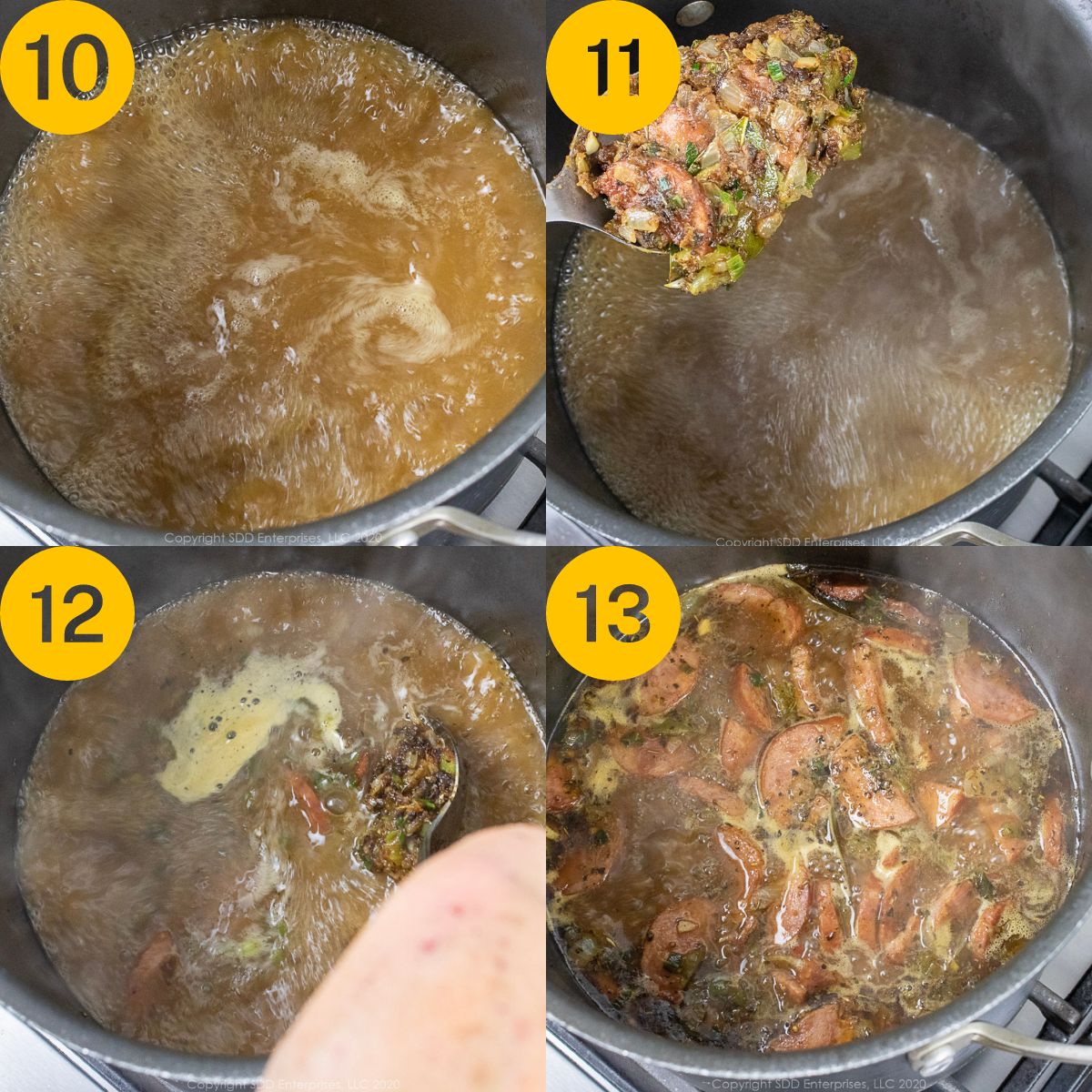
10) Meanwhile, back at the stockpot, bring the stock to a full rolling boil.
Lagniappe Tip: Now it's time to mix the veggie, roux, and sausage into the stock. You can turn the heat off under the roux/veggie mix while the stock is at a full, rolling boil.
11) Using a slotted spoon, mix one spoonful of the veggies into the boiling stock.
12) Stir until the entire spoonful of the veggie/roux mixture is dissolved into the stock. Repeat this, one slotted spoonful at a time, until all the veggies are blended into the stock, making sure to return the stock to a full boil between spoonfuls.
Lagniappe Tip: The idea is to combine the roux mixture with the stock so that it's smooth and without lumps. Can you do it all in one pot? Sure. I find it a little more trouble adding the stock to the roux. You need to do it slowly and make sure the Dutch oven is large enough to hold the entire gumbo. Using this two-pot technique, it's easier to blend small amounts of roux mixture into the stock and eliminate lumps than it is vice versa.
13) Once all the roux/veggie mix has been incorporated into the stock, add about half of the remaining Herb and Spice Blend and keep the stock at a high boil for 5 to 10 minutes which encourages all the flavors to come together.
Note on the chicken: If you are using raw chicken, add it in slowly now, much like you did the veggie mix, stirring in between adding bits of chicken. If you are using chicken from making the stock, hold off on adding it in for a while.
Simmer 1-Hour Covered
What happens in this step: Now that all the ingredients are together, a long simmer will meld all the wonderful flavors into a great gumbo!

14) After about 10 minutes, turn the heat to low, cover the pot and simmer for about 1 hour. Stir occasionally so that it doesn't stick. After the hour, taste the gumbo for any additional seasoning.
15) If you are using the cooked chicken, add it a little at a time now. Stir well and simmer the stock for 15 to 30 minutes, uncovered while the flavors meld.
16) Remove the stock pot from the heat and let it sit, covered, for about 10 minutes, then dip some of the fat that has risen to the top.
Note on the Rice: Cook about 2 cups of raw rice according to the package instructions. This will yield about 6 cups of cooked rice. Set aside.

Serving Suggestions
The stock has thickened and the chicken and sausage have fused their delicious flavors with the rich roux and vegetables. Remove the bay leaves; mound about ½ cup of white rice in the middle of the bowl and ladle the gumbo right on top. Don't overdo it with the rice, it's "soup-like" not rice and gravy!
This gumbo is traditionally served with potato salad (in certain regions of Louisiana, potato salad is served in the gumbo in lieu of rice.) Other great side dishes are Sensation Salad, Dirty Rice, and Maque Choux. Don't forget the crispy French bread! Other side dish suggestions are listed below the FAQ section.
Sign up for my email notifications of new recipes and posts right HERE.
Hints and Tips (FAQ)
Potato Salad is a traditional side dish for gumbo in many parts of Louisiana. Crispy French bread and a nice green salad are natural accompaniments for gumbo.
Andouille brings a lot of flavor to this gumbo. There are many brands of Andouille and they each have their own flavor profile. If none are available, or you can't find one that you like, you can substitute any smoked pork (or chicken) sausage. A good kielbasa is a good substitute.
No, gumbo is a thick roux-based soup-like dish that is served over rice. Étouffée is crawfish, shrimp, chicken or any number of other proteins smothered in a rich gravy, thickened with roux and served over rice. Jambalaya is a combination of vegetables, spices and proteins cooked with raw rice in stock so that the rice absorbs the wonderful flavors as it cooks. Here are my recipes for Cajun Jambalaya, Creole Jambalaya, Crawfish Étouffée, and Shrimp Étouffée.
Okra is a common ingredient in many types of gumbo, but it is not necessary. In fact, the term “gumbo” means okra and is derived from African influences in our culture. Okra imparts its unique flavor to gumbo but also is used as a thickener. This Gumbo Ya-Ya recipe relies on a dark roux and a slow simmer for thickening.
Filé (pronounced FEE-lay) is the powder derived from ground sassafras leaves. It’s also used as a thickener in gumbo and can be cooked into the recipe or sprinkled on top of the finished gumbo. Again, this is a common, classic ingredient in Cajun and Creole recipes, but it's not necessary for real authentic gumbo.
This Gumbo Ya-Ya is one of those recipes that tastes better the next day. Allow the gumbo to cool down to room temperature, then store leftovers in the fridge for 3 to 4 days in an airtight container. It can be reheated in batches in the microwave or in a saucepan.
This gumbo can also be stored in the freezer for about 6 months in an airtight container. You can thaw it in the fridge overnight or on top of the stove in a saucepan over low heat.
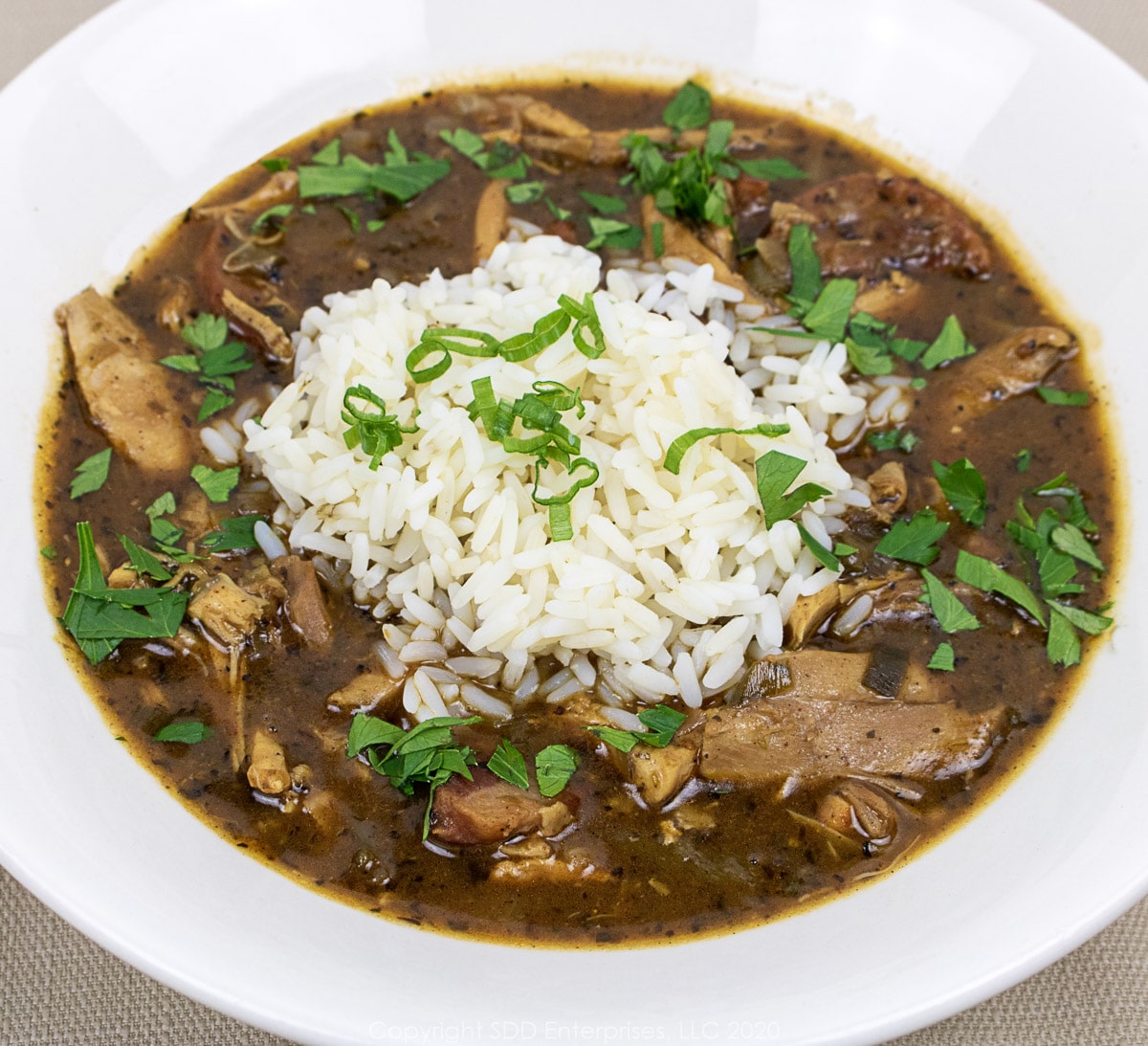
Other Sides, Gumbos, and Bisques
Sides
Gumbos
Bisques
If you make this recipe:
- Tell us about it in the Comments section below
- LEAVE A RATING ON THE RECIPE-worthy of 5-Stars?
- Questions or Comments? that’s the place!
- SIGN UP FOR OUR EMAIL UPDATES so you don't miss anything!
- Post a picture and share it with your friends on our Social Media:
Yeah You Right!
Recipe
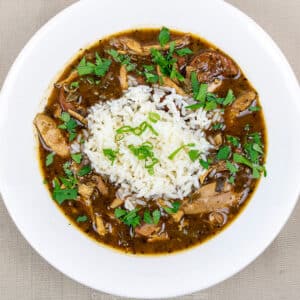
Chicken and Andouille Gumbo (Gumbo Ya-Ya)
Here's What You Need
- 8 cups Chicken Stock See Recipe Notes
- 2 pounds white and dark meat chicken See Recipe Notes
- 1 pound Andouille Sausage sliced in medallions
- ¾ cup vegetable oil
- ¾ cup all purpose flour
- 2 large Yellow Onions diced
- 1 large green pepper diced
- 2 stalks Celery diced
- 2 bunches green onions diced
- 5 cloves garlic chopped
- 2 whole chicken wings optional
Herb and Spice Blend
- 2 tablespoons Oregano
- 2 tablespoons Basil
- 1 ½ teaspoons Thyme
- 1 tablespoon Creole seasoning plus a little more for the chicken
- 1 tablespoons White Pepper
- 1 tablespoon ground black pepper
- 1 ½ teaspoons kosher salt
- 2 bay leaves
Here's What You Do
Mise en place
- Slice the andouille sausage into medallions, set aside. Cut the chicken into bite-size pieces; if using cooked chicken, shred, pull or chop chicken. Place in a bowl and mix in Creole seasoning and set aside.
- Measure out the flour and vegetable oil; chop the vegetables and set aside; chop the garlic and set aside in a small bowl; mix the Herb and Spice Blend in a small bowl and set that aside.
- Place the chicken stock in a stock pot and start heating it on low. Keep it covered and on low so it does not reduce.
Steps for the Gumbo
- In a large cast-iron Dutch oven over medium-high heat, sauté the sausage until browned and rendering some of its fat. Scrape the brown bits off the bottom. When the sausage is nicely browned, remove it from the Dutch oven, leaving the renderings in the pan. About 5 minutes.
- Maintaining the medium-high heat, add the vegetable oil to the frying pan. When the oil is shimmering add the flour to make a dark roux. About 10 minutes.
- As soon as the roux is dark enough add the Trinity (yellow onions, bell peppers and celery) about a half or a third at a time. Stir to completely mix the veggies with the roux. (Tip: if the roux continues to darken, you can periodically remove the pot from the heat while you stir the Trinity).
- Continue to cook the Trinity over medium-high heat, stirring frequently and scraping the bits off the bottom, careful not to let it burn or scorch. This will take at least 15 to 20 minutes.
- Add in the garlic and green onions and continue to cook until aromatic, usually a couple of minutes.
- Add about half of the Herb and Spice Blend and the 2 bay leaves; add back the sausage; mix well and cook for another five minutes.
- Turn up the heat on the stock pot and bring the chicken stock to a rolling boil.
- Using a slotted spoon, mix in the veggie/sausage mix, one spoonful at a time, stirring each spoonful until everything is blended and mixed with the stock, making sure it returns to a rolling boil in between each spoonful. Continue this, one spoonful at a time until all the veggie/sausage mix has been added to the stock. About 10 minutes.
- Add the chicken, a few pieces at a time, stirring them into the stock in a similar fashion as you did the veggies, letting it come back to a rolling boil between each spoonful. (Tip: If you are going to throw in a couple of chicken wings, now is the time. If using cooked chicken from making stock, we will add that later).
- Add a little more of the Herb and Spice Blend, stir well.
- Turn the heat down to low, cover the pot and simmer for about an hour, stirring occasionally.
- Uncover and simmer about 15 to 30 minutes as the gumbo thickens. If using cooked chicken from making the stock, add it now, a little at a time. Stir to combine.
- Prior to serving, skim off the grease which has floated to the top. Give the gumbo a good stir then taste for seasoning-add a little more of the spice mix or some more salt and black pepper, if needed.
- Remove the bay leaves and serve over white rice.
Recipe Notes
Nutrition Estimate
This article was revise in October 2023 with improved step-by-step images, more detailed instructions, and more tips.





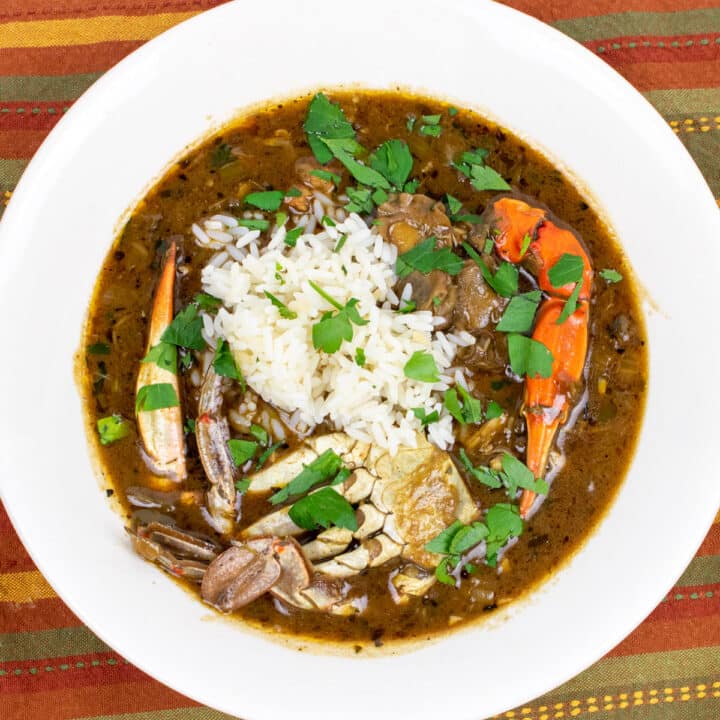

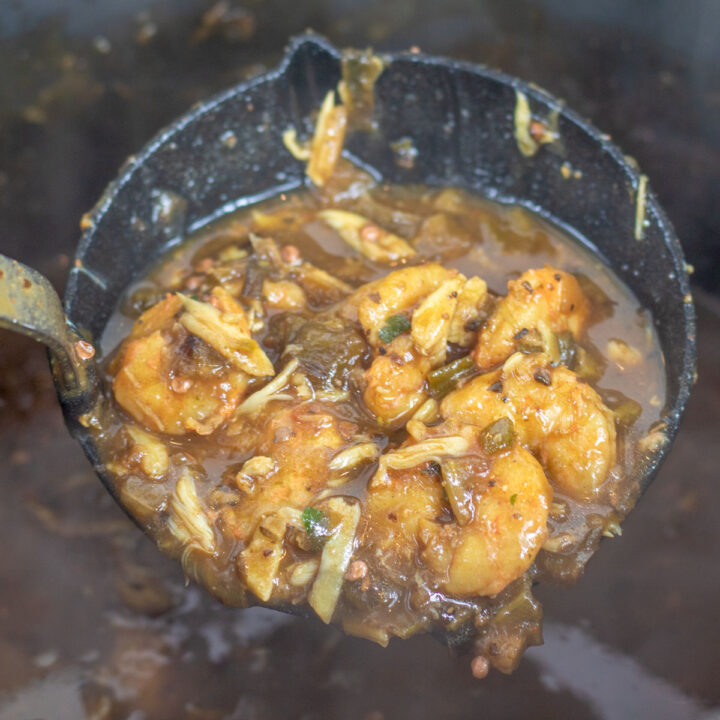
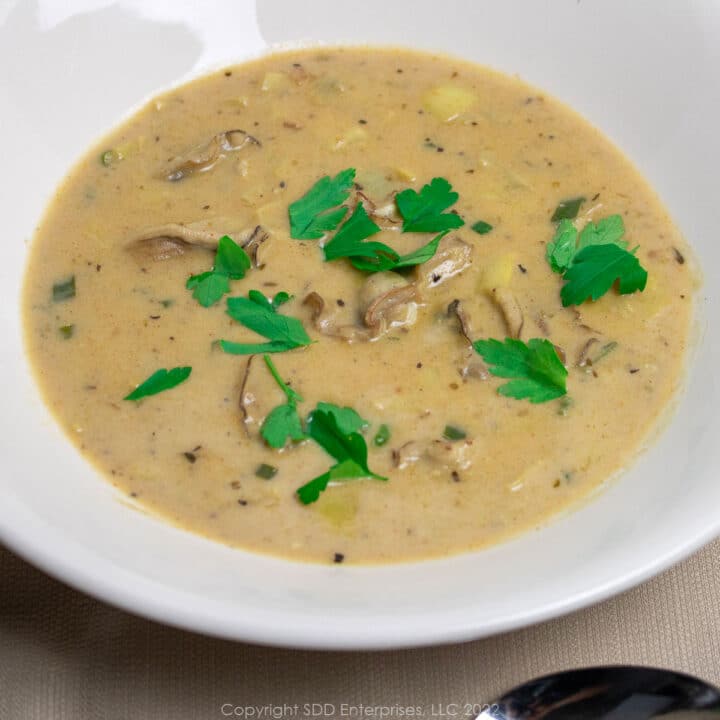
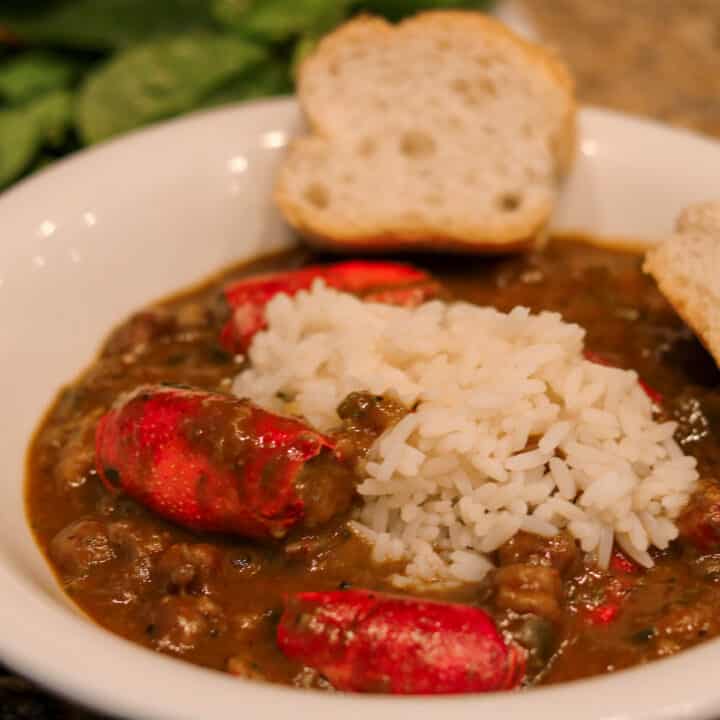
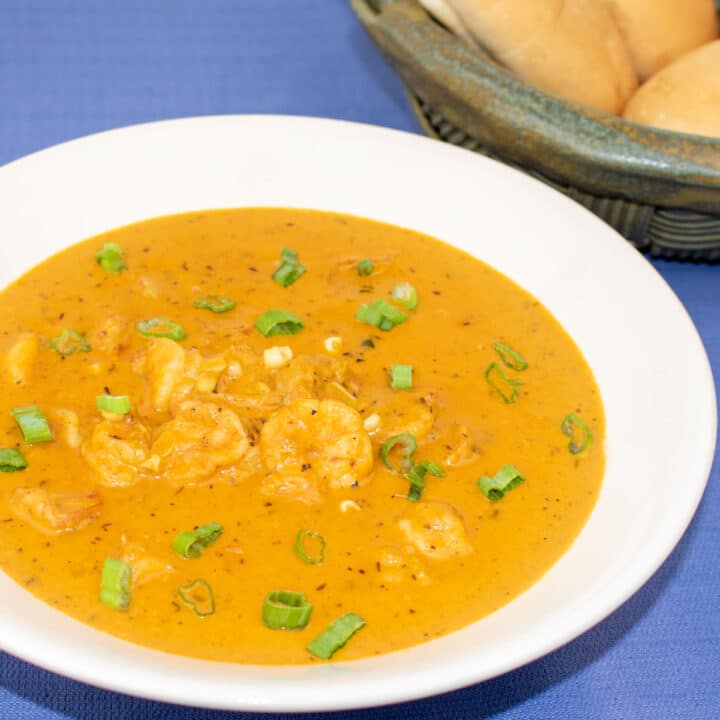

Christie
I am born and raised in South Louisiana and make a couple of different gumbos. I made this for my father-in-law's celebration of life. It was nice to listen to his favorite music while taking my time making this recipe. It was a huge hit. I will definitely make this again. I love your recipes and website.
Sweet Daddy D
Thanks, Christie, I appreciate you giving my recipes a try. Its all about family and I'm touched to hear you cooked one of my recipes for your special family event.
Rachel
Found this recipe after a few attempts looking for a Gumbo Ya-Ya one. I made it last night and it turned out fantastic!! I will definitely be trying more recipes from this site! Thank you!
I did differ from the recipe by using store bought stock and a rotisserie chicken (trying to cut corners with two young kids running around 😁)
Sweet Daddy D
Rachel, thanks for the kind words. I appreciate you trying the recipe and am so glad you liked it. Honestly, substituting the rotisserie chicken is perfect and I use store-bought Kitchen Basic stock most of the time when I make this recipe. Thanks, can't wait to hear what you try next!
Jessica
Hi, Do you used dried herbs? Thanks!
Sweet Daddy D
Hey, Jessica. For the recipe, I did use dried herbs but you can use fresh herbs if you prefer. I would suggest adding them later in the cook. Dried herbs have more intense flavor than fresh, so you should use more fresh than dried (like 2 to 1 or 3 to 1). Thanks for the comments.
Jessica
Perfect! Thanks so much for the info. I made your jambalaya this week and now I want to try all your dishes. I wish you had more desserts though 😊
Sweet Daddy D
Thanks, Jessica. I've got a lot of deserts on my list, just haven't had time to get to them. I will at some point. Thanks for reaching out, glad you liked the Jambalaya!
Rudolph Schmidt Hirsch
Amazing recipe! Authentic New Orleans Creole Gumbo Ya Ya. Savor this dish while reading the classic book "Gumbo Ya Ya - Folk Tales of Louisiana" by Robert Tallant and Lyle Saxon. Sweet Daddy D's recipe for Gumbo Ya Ya - chicken and andouille gumbo is the quintessential recipe for this traditional rich meal. We follow Daddy D's recipe other than simmering a whole chicken in the seasoned stock and then de-boning it. Excellent seasoning and flavor. I made a bit pot and shall happily eat it Several Time!
Sweet Daddy D
Yeah you right, Rudy!
Mick
This came out fantastic. I didn't find andouille at the store and with the virus going around I didn't want to make a special trip to another store so I used some Jalapeno Kielbasa they had and it was great in this. I already had some home made stock on hand so I pre cooked my chicken in the fat from the sausage and set aside. The spice level on this was perfect. Better than gumbo I've had at many restaurants.
Sweet Daddy D
Hey, Mick. I appreciate you trying the recipe and thanks for reaching out. I'm so glad you liked it. That sausage sounds great, I bet the jalapeno was a perfect fit. If you try different, good quality sausages, you'll see how that can affect the flavor profile. That's the way to do the chicken and the way I do it most of the time. Thanks again! Yeah you right!